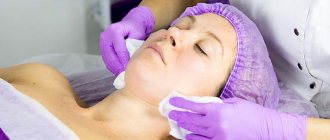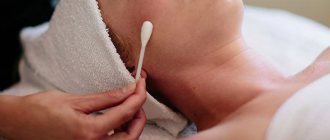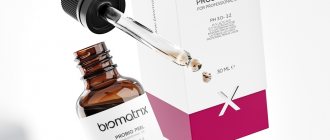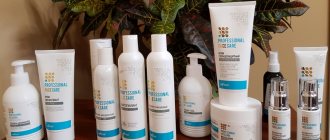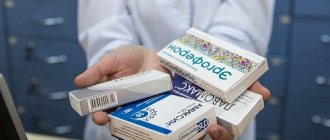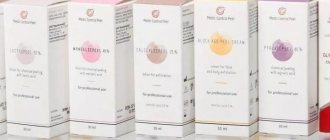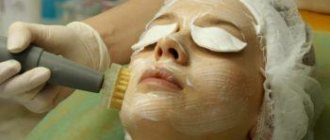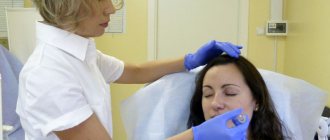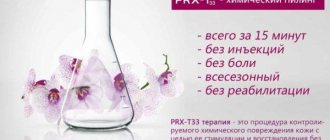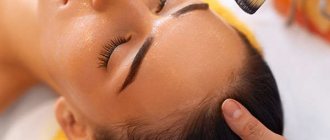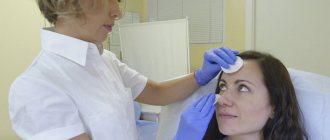Chemical peeling is iatrogenic damage to certain layers of the epidermis and/or dermis.
In response to damage, a huge amount of pro-inflammatory mediators, growth factors, and biologically active substances are released, which leads to the activation of protective regenerative mechanisms, an increase in the metabolic and mitotic activity of basal keratinocytes and fibroblasts. The expected effects of the chemical peeling procedure are improvement of the appearance of the skin: color, smoothing of the skin profile, improvement of micro- and macrorelief, activation of reparative processes, increased synthesis of epidermal lipids and extracellular structures of the dermal matrix. The effect depends more on the depth of skin damage and less on the chemical preparation. The stimulating effect of chemical peeling is indirect. This is the skin's reaction to inflammation that develops as a result of skin damage.
Classification
- Superficial peeling (within the stratum corneum) minimal inflammatory reaction, m/painful, the safest. AHA, aβ-complexes, phytic, Jaisner, 1-15% TCA.
- Median (within the Malpighian layer). Medium peeling is accompanied by necrosis of the Malpighian layer, with the development of a pronounced inflammatory reaction (hyperemia, edema) and severe peeling; the rehabilitation period is 7-14 days. Allows you to change (smooth) micro- and macrorelief. Recommended for the correction of superficial wrinkles, enlarged pores, post-acne, and stretch marks. 15-25% TCA, combined TCA + enzyme (papain), Blue peel, Krulig peeling, phenol.
- Deep (with damage to the papillary dermis)
The only type of peeling that allows you to correct wrinkles, a high risk of scarring, rehabilitation up to 1.5 years. 25-50% TCA, phenol up to 40% - the “gold standard” of peeling. The most effective, the most toxic. It has a selective cytotoxic effect on melanocytes - recommended for the correction of hyperpigmentation.
Cost of acid peeling in a beauty salon
The cost of the procedure is affected by the type of acid used and its concentration. In addition, the price depends on the drugs used after cleansing the skin. The formation of the price tag is influenced by the rating of the salon, the region where it is located, as well as the qualifications and experience of the specialist performing the procedure. The average cost of a session is approximately 2,500–16,000 rubles.
The price also depends on the type of cleansing procedure. For example, superficial peeling will cost from 2,500 to 3,500 rubles, medium peeling can be done for 3,000–5,000 rubles, and deep peeling will cost from 5,000 to 6,000 rubles.
If the procedure is carried out using trichloroacetic acid, its cost will be 6,000–7,000 rubles. Peeling with retinoic acid is one of the most expensive. Its cost is approximately 11,000–16,000 rubles.
Why clients choose Veronika Herba Beauty and Health Center:
- This is a beauty center where you can take care of yourself at a reasonable cost, while your face and/or body will be treated not by an ordinary specialist, but by one of the best professionals in Moscow. This is a completely different, higher level of service!
- You can receive qualified help at any time convenient for you. The beauty center is open from 9:00 to 21:00, seven days a week. The main thing is to agree with your doctor in advance on the date and time of your appointment.
Sign up for a consultation with a specialist by phone +7 (495) 085-15-13
, and you will see for yourself!
Superficial chemical peeling AHA
When talking about superficial chemical peeling, we primarily mean peeling with AHA, or fruit acids.
The first mention of cutaneous use of AHA dates back to 1974. Van Scotch and Yu, studying the effect of various drugs for ichthyosis, found that glycolic acid is able to control the processes of keratinization of the epidermis, weakening the adhesion between corneocytes. Subsequently, the therapeutic effectiveness of ANA was established for all forms of hyperkeratosis.
The AHA group includes: glycolic, lactic, apple, tartaric, lemon
Composition of acid peeling
Each acid affects the skin layers differently. The correct choice of active ingredients affects the results obtained.
- Fruit acid. It is one of the weakest. It is usually used when age-related changes are not yet very noticeable. Fruit acid can be used at home. The active ingredients are often grape, mangrove, cane or sugar acids. After peeling using these components, the skin becomes firmer and more elastic.
- Mandelic acid. It is used for antibacterial treatment of the skin. It helps reduce the severity of scars after acne and acne.
- Salicylic acid. It is most often used for patients with dark skin, as well as with seborrhea or for people suffering from hyperpigmentation or acne.
- Lactic acid. Rejuvenates the skin, makes it softer and more tender.
- Retinoic acid. This active substance is usually used in cosmetic medical institutions. The acid has a pronounced effect. For different age categories, the optimal concentration of the substance for exposure is selected. The stage of a chemical burn depends on the degree of acid concentration.
- Glycolic acid. This substance is intended to cleanse the top layer of skin (epidermis). With the help of glycolic acid, you can remove rashes and pigmentation, get rid of dirt plugs and sebaceous deposits.
The clinic specialist selects the procedure scheme, the type and concentration of the active ingredients, as well as the exposure time individually for each patient.
Many people think that without peeling and crusting on the skin, there is no effect from the procedure. This is a misconception, since some peels do not cause such a skin reaction as peeling.
Indications for use
Biological aging of the skin. Almost all types of peelings are used to correct signs of aging. The choice of one procedure or another is determined primarily by the severity of cosmetic defects. ANA peeling optimal age 23-30 years (prevention of aging), no correction of age-related changes. Number of procedures 4-6, ANA concentration 50-70% Additional components: antioxidants
Photoaging is changes in the skin under the influence of UV rays. 50-70% ANA, number of sessions 8. The most promising is the combination of ANA with antioxidants and whitening agents.
Pigmentation -
- dyschromia - 70% ANA, amount 8. Optimally αβ-complexes
- chloasma, hyperpigmentation - it is recommended to use AHA up to 50%, as inflammation can cause increased pigmentation. Pre-peel preparation is required to reduce the risk of increased hyperpigmentation, includes the use of phytic acid 3-10%, combined preparations of glycolic acid + kojic acid, ascorbic acid, glabridin, antioxidants that reduce inflammation are recommended, and the use of UV filters is mandatory. Number of sessions 8.
- Comedonal, papulopustular form of acne. Initially, the use of ANA for acne vulgaris was limited exclusively to the treatment of post-eruptive hyperpigmentation and scarring. This was the only method for correcting secondary skin changes in this disease, which is possible even against the background of unresolved inflammatory elements. Subsequent clinical observations showed that the use of this group of drugs significantly accelerated the relief of the inflammatory process and extended the time of remission
How to choose peeling depth
When selecting a peel, you need to evaluate:
- How deep is the problem you plan to deal with: above or below the basement membrane?
- Condition of skin barriers . How wealthy are they due to their skin condition/disease.
* For example, with inflamed acne or rosacea, the skin is often sensitive, and it is better to choose a superficial peel here.
Before assessing the depth of the problem in the skin, we will divide them into the three most common ones that are addressed to a cosmetologist:
1. Age-related changes and wrinkles
2. Acne and problem skin
3. Age spots
AGE CHANGES
The choice depends on the manifestations of age-related changes:
- Superficial wrinkles, hyperkeratosis, dry and dehydrated skin -> the optimal choice is superficial peeling with a pH of 3.5 - 2.5.
Acids will remove layers of horny masses and wrinkles, and professional pH will improve lymphatic drainage, hydration levels and increase immune function.
- Deep wrinkles - creases, sagging skin against the background of decreased cellular renewal and fibroblast activity -> medium peels .
DARK SPOTS
Before choosing the optimal peeling depth, you need to determine the depth of the pigment. It is necessary to be very careful in selecting and performing a lightening peel and prescribing additional home care products, because excessive trauma can provoke post-inflammatory pigmentation.
- Superficial diffuse pigmentation lies above the basement membrane - accordingly, superficial or superficial-medium peeling is suitable.
Ideally, choose a brightening peeling that contains not only acids, but also lightening substances.
- Deep pigmentation lies under the basement membrane - choose a medium peel with a pH of 1.5. It will provoke active lymphatic drainage and cellular renewal, washing out the pigment.
PROBLEM SKIN AND ACNE
And here you need to determine where the problem is located - at what level:
- On the surface - hyperkeratosis, papules, pustules, untidy skin, irritation.
In these cases, you need to work on the surface for good cleansing of excess horny masses, removal of colonies of pathogenic flora and restoration of the skin microbiome.
- Deep inflammatory elements
If the inflammation process is active and new acne elements appear regularly, peelings are not used!
In the presence of deep nodular rashes that do not resolve on their own or during home care, superficial-medium peels with a pH of 2.5-3.0 are recommended. They will eliminate the problem by improving lymphatic drainage: absorbing effect and stimulating the immune function of the skin.
Azelaic acid and other anti-acne substances are desirable in the formulations.
Medium chemical peels
TCA (15-25%) is a keratolytic, causing protein coagulation. Non-toxic substance.
When applied to the skin, TCA causes the formation of a frost effect. Depending on the depth of necrosis, the following types of frost effect are distinguished:
- Pink frost: “pointed” - throughout the entire depth of the stratum corneum; “clouds” - granular layer
- White (milky): translucent film - the border of the granular and spinous layer
- White deaf, compact: up to the basement membrane, dermal papillae
- Solid white with a yellowish/greenish tint: up to the reticular layer (there will be a scar in this place).
Using acid peeling at home
Acid peeling can be done at home in a variety of ways. Currently, there are many cosmetic products containing active acids.
- A mixture of strawberries, pineapple, apple, banana is applied to the face and left to act for 20 minutes. Then the mask is washed off with warm water and a moisturizer is applied.
- Acid peeling can be purchased at a pharmacy. It is important that it matches the age characteristics of the skin. Products with citric, lactic, mandelic, and grape acid are suitable for home procedures.
- You can cleanse your facial skin with natural lemon, which has a degreasing and whitening effect. A cotton pad is moistened with freshly squeezed juice. After 10–15 minutes, rinse with warm water, after which moisturizer is applied to the skin.
- Cleansing mask with sour milk, sour cream, natural yogurt and lactic acid (4%) and oat bran. The mixture is applied to the face and left for 20 minutes, after which it is washed off with warm water.
- Grape acid is used for mature skin. During such acid peeling, according to customer reviews, a tingling sensation is felt. This method is not recommended for people with sensitive skin.
If peeling is carried out at home, it is better to purchase ready-made cosmetic formulations. Natural products are also suitable as they are safer. They can be safely used without fear of burns and other unpleasant consequences.
Experts recommend using mineral water, which has a neutralizing and calming effect, to wash off the acidic composition.
However, to achieve a positive result, it is better to perform peeling in a beauty salon.
Contraindications
Absolute:
- Dermatoses in the acute stage (especially herpes infection)
- IV,V,VI skin phototype
- Tendency to form hypertrophic and keloid scars
- Rehabilitation period after other cosmetic procedures (Botox - 14 days, microimplants - 1 week, laser resurfacing, dermabrasion - no earlier than 1 year)
- Pregnancy, nursing (painful procedure)
- Mentally labile patients.
- Thin, sensitive skin with reduced regeneration
Relative: nevi, rosacea, hypertrichosis, spring-summer period
Expected skin reactions occurring immediately after a chemical peel (1-14 days):
- Edema. Most often, swelling and pastiness develop with deep peels. With superficial peeling, swelling is moderate or absent. It develops on the first day after the procedure, reaches a maximum on the 3rd day, and disappears by the 5th day. The severity of edema varies for each patient; it most often develops in people with thin and loose skin. It is extremely rare that after deep peels, significant swelling of the eyelids, neck and upper chest may develop. But there is never any swelling of the upper respiratory tract or any systemic damage after a chemical peel. There is no need to prescribe special therapy for the treatment of edema. Prophylactic administration of steroids does not prevent the development of edema. Although a number of authors recommend the use of glucocorticoids in a short course, both intravenously (during the procedure) and orally for 5 days, because this can significantly reduce swelling. As a rule, cold compresses are used more often to prevent swelling of the eyelids.
- Hyperemia. With superficial and medium peels, the erythema is moderate and disappears by 3-4 days. With deep peeling, erythema may persist for up to 1-2 months after the procedure. The most pronounced erythema occurs after laser resurfacing and dermabrasion. It appears immediately after the procedure. After 7-10 days, its intensity decreases, but it can persist for up to several months. This is due to the fact that during these procedures the dermis is “exposed”.
- Darkening of the skin. After a TCA peel, the epidermis often turns dark brown. After 3 days, separation and exfoliation of the destroyed layers of skin begins, which reaches a maximum by 5-6 days and completely stops by 7-14 days. As a result, the regenerated new skin has a pink color. Αβ-peeling
A combination of glycolic and salicylic acids. It is a superficial-medium peeling. Incoming salicylic acid (keratolytic) potentiates the penetration of glycolic acid.
The technique is similar to AHA peeling. Brighter erythema after 15-20 seconds, intense burning, possible frost effect. Exposure up to 1-2 minutes. Indications: thick, porous skin, post-acne.
Technique
A good chemical peel for the face in a cosmetic clinic is carried out in four stages:
- Cleaning and disinfection. The skin is treated with a special milk or gel containing a weak solution of glycolic acid with surface active components. This allows you to reliably degrease the areas to be treated and eliminate contamination. The use of soap is not allowed, as this leads to severe alkalization of the skin and reduces the effectiveness of peeling.
- Application of the active agent. Using a fan brush, a cosmetologist evenly treats the skin of the face in a certain sequence: forehead, temples, chin, neck, center. The preparation for chemical peeling of the face is not applied to the moving part of the eyelids. During the procedure, the cosmetologist constantly monitors the patient’s condition and maintains precise timing. A slight burning sensation is considered normal, but should not become unbearable. After diffuse erythema appears on the skin, proceed to the next stage of the procedure.
- Neutralization of acid. Deactivation of the peeling agent is carried out using a special neutralizer. It completely stops the drug from working. Residues of the base substance and neutralizer should be washed off with cool water. Chemical glycolic facial peeling does not require the use of deactivators. The product is removed from the skin surface by simple washing.
- Post-peeling care. After deactivating the acid, the cosmetologist treats the patient’s face with a special post-peeling cream. This is necessary, since during the procedure the epidermis is severely dehydrated and needs to compensate for fluid loss.
In the future, it is necessary to use sunscreens, moisturizers, and wash your face twice a day with a warm chamomile decoction without detergents. If your skin feels dry and tight, it is recommended to spray your face with a thermal spray. After medium chemical peels of the face, crusts form on the face and crack. It is forbidden to tear them down by force. Hydrocortisone ointment is applied to the damaged areas. Peeling and separation of crusts stops by 5–7 days after the procedure.
Peeling results
Facial skin peeling allows you to achieve the following positive changes:
- the color and texture of the skin becomes smoother;
- fine wrinkles disappear;
- deep wrinkles become less noticeable;
- a prolonged effect of skin moisturizing is achieved;
- the tone of the outer integument of the body increases;
- zones of hyperpigmentation are eliminated or become almost invisible;
- local immune reactions are enhanced.
Consequences if the procedure is carried out incorrectly
These changes are achieved after complete restoration of the skin. Until this point, a person may experience certain negative consequences, which soon go away on their own. These include:
- For superficial peeling – persistent erythema, dyschromia, infection, contact and allergic dermatitis. Similar reactions are accompanied by chemical glycolic facial peeling.
- For medium peeling – the appearance of a peeling crust and burn exudate.
- For deep chemical peeling of the face – the appearance of erythema, pastiness, local inflammatory reaction, swelling.
It must be remembered that all of these conditions fall into the category of expected and completely controllable. They do not pose a threat to life, health or appearance, and if all recommended recovery measures are followed, they pass without delayed consequences.
Acne vulgaris: treatment with Azelik® gel
Peeling is only an auxiliary measure for acne vulgaris; treatment should be prescribed by a dermatologist, not a cosmetologist. One of the drugs used in the treatment of mild to moderate acne vulgaris is Azelik®5 gel. Its main active ingredient is azelaic acid5. The drug has the following properties5:
- exhibits antimicrobial activity against Propionibacterium acnes and Staphylococcus epidermidis;
- helps normalize keratinization processes;
- helps reduce the level of fatty acids;
- helps relieve inflammation by reducing the metabolism of neutrophils and their production of free radical forms of oxygen.
Azelik® gel should be used twice a day, applied to clean, dry skin5.
*acne
❄
Retinoic peels belonging to the superficial category have gained particular popularity recently. Retinoic peels are also known as “yellow peels” or “weekend peels” (due to the short recovery period). The mechanism of action of retinoic peels is fundamentally different from the mechanism of action of other peeling agents. The retinoids included in the “yellow peeling” do not damage the skin, do not destroy living cells, and do not coagulate proteins. They interact with specific nuclear receptors of cells. Principles of action and types of chemical peels remove dead skin layers by stimulating the regeneration of young cells.
These receptors have been found in basal keratinocytes, melanocytes and fibroblasts. Thus, as a result of the effect of retinoic peels on the epidermis, the level of mitotic activity of basal keratinocytes increases, the processes of differentiation and keratinization, as well as melanogenesis are normalized, the synthesis of epidermal lipids and components of the intercellular matrix of the dermis is activated and stimulated, and the number of atypical cells is reduced. As a result, skin aging slows down, its texture improves, its relief is evened out, and a pronounced rejuvenating and brightening effect is achieved. In addition, yellow peel retinoids have a powerful antioxidant effect. Histological studies have shown that the stimulating effect of retinoic peels on the cellular structures of the skin persists for 4 months after the last application of retinoids. Other important reasons for the demand for retinoic peels are their atraumatic nature and high safety of use, a short post-peeling period and an extremely low rate of complications. Therefore, retinoic peeling can be carried out in the summer.
Effects of body peeling procedure
After the first session, you will notice how the skin color in the treated area has improved and its texture has evened out. Over time, the result will improve and include: alignment of skin texture and color; lifting effect; lymphatic drainage; cleansing and reducing pores; stimulation of elastin and collagen synthesis; stimulation of your own skin renewal processes. To achieve a complete and lasting result, the number of body peeling sessions is calculated individually and depends on the characteristics of the patient, the nature of the problems, their duration and degree of complexity. As the practice of our doctors shows, to obtain an amazing and long-lasting result, you need to complete a course of at least 4 procedures. Body peeling makes it possible not only to solve the problem of aesthetic skin defects, but also to have a complex stimulating effect on the body. It helps improve skin respiration, increases skin turgor, its smoothness and moisture, and eliminates swelling. In addition, the technique also gives a charge of vivacity, good mood, a feeling of lightness and vitality.
